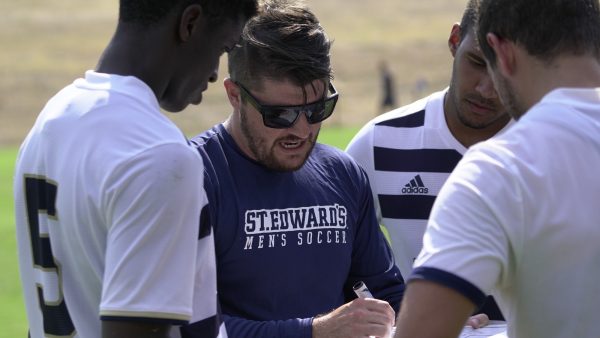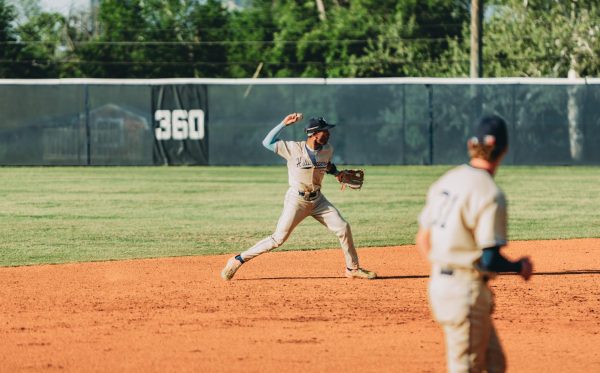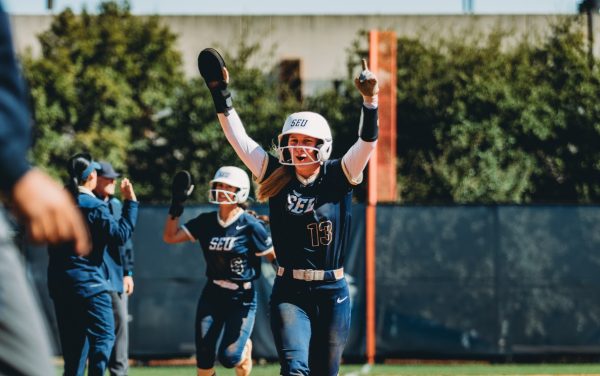New act balances sports with school
For senior volleyball player Chelsea Barsamian, life has been a balancing act of juggling volleyball, academics and her social life while attending St. Edward’s University.
Barsamian begins a typical day with class at 8 a.m. After a morning full of classes, she grabs lunch before heading off to study hall. She then has a short break before she gets ready for practice at 4:30 P.M. Her day finally ends at 8:30 P.M. when she leaves practice.
“The past three years, our seasons have been very long and would last close to finals,” Barsamian said. “Knowing finals is the most critical time of the semester and the conference tournament is the most important time of the season, they both require a lot of focus and it has been hard to find the balance.”
The NCAA-Division II has been working to assist struggling student-athletes this year in finding balance between school and athletics. The Life in the Balance Act was developed to allow NCAA Division II athletes to focus more on their studies while also allowing them to have the full college experience. It is also designed to help save universities money.
At the first Student Athlete Advisory Committee meeting of the school year, held on Sept. 1, Barsamian, senior volleyball player and SAAC president, and Chris Maggot, athletic trainer and SAAC advisor, informed all St. Edward’s SAAC sports representatives of the new Life in the Balance Act.
SAAC is run by student athletes, and representatives from each sport attend the meetings to vote on ways to improve relationships between athletes, the athletic department, and the university.
Also, as the liaison to the NCAA, one of SAACs duties is to notify student-athletes of new rules and regulations.
“The new act was created so that we can experience life as a college student, not just an athlete,” Barsamian said while giving a briefing on the regulations of the act. “Life in the Balance will allow athletes more time to focus on studies as well as have a chance to get to know other students through involvement in other campus organizations and social activities.”
The Life in the Balance Act was instated at all NCAA Division II schools throughout the nation beginning this year.
The act cuts the number of competitions that all sports are allowed to partake in during a single season, reduces the amount of practice hours permitted, and shortens the length of each sport’s season.
Men and women’s soccer and women’s volleyball are the first sports feeling the effects of the new act due to a shorter preseason period.
“I think by shortening preseason from two weeks to one helps because it forced us to work harder over the summer,” Barsamian said. “We all knew that the first day we had to be ready to go and focus on building our team chemistry and level of play up to pick up where we left off in the spring.”
Preseason has fall athletes move back to campus early to start preparing for the upcoming season before classes begin. During this time, the teams work on bonding with each other and developing their cohesion as a team.
With athletes staying on campus a week less, the university saves money spent on feeding and housing athletes who live on campus.
“By preseason being shorter, we have to provide less meals before Ragsdale opened and meal plans became activated, thus decreasing the amount we spend each year,” Maggot said.
Along with its advantages, negative effects of Life in the Balance have also been noted.
“The shorter season can also build stress on athletes due to more games per week, a condensed season, more traveling in less time, and I am personally missing class more than I have in my previous three seasons of volleyball,” Barsamian said.
Although the act is intended to make life as Division II student-athletes less stressful, in some cases it has had the opposite effect.
“I believe that the Life in the Balance Act, although a good idea, actually detracts from the academic experience at the DII level. Since preseason was cut short, I feel that the coaches tried to cram three weeks of preseason into one-and-a-half,” men’s soccer goalie Matt Moore said. “I have never felt more pressured as an athlete. Practices have been longer, and extend as far as NCAA regulations allow.”
Whether the act serves its initial purpose or not is up to the student-athletes.
“I think the Life in the Balance Act will give student-athletes better tools to juggle their athletic, academic and social lives,” Maggot said. “How much the athletes choose to use those tools and use them correctly will be up to them. A large part of making this act successful is the student-athletes accepting some responsibility and using their extra time wisely.”






